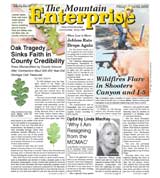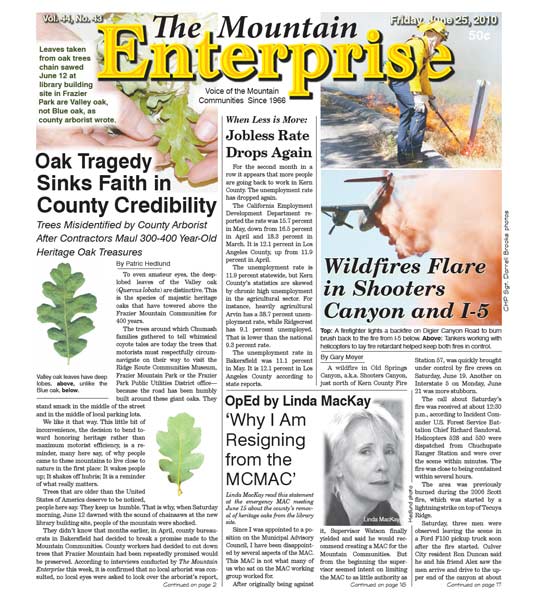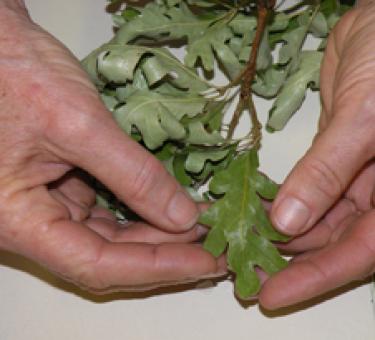
Image 1 of 5
Leaves taken from oak trees chain sawed June 12 at library building site in Frazier Park are Valley oak, not Blue oak, as county arborist wrote. See following images for closeups of both types of leaves.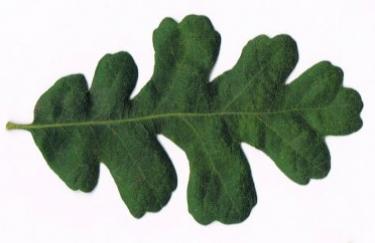
Image 2 of 5
Valley oak leaves have deep lobes (above), unlike the Blue oak (next).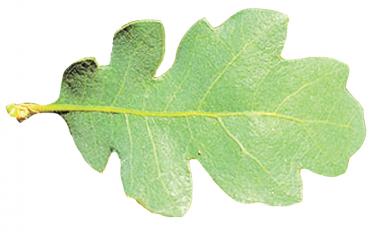
Image 3 of 5
Blue oak leaf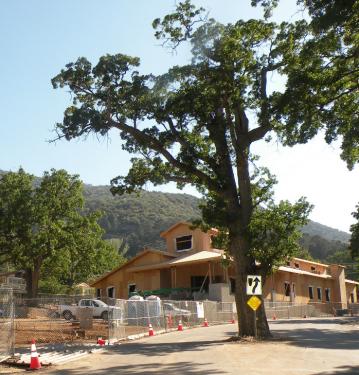
Image 4 of 5
Frazier Park has a long tradition of living humorously with its shady oaks. They appear in the middle of roads and are gratefully part of local parking areas. This one is right in front of the library building site where two oaks, 200-400 years old, were chain sawed and the wood carted away June 12.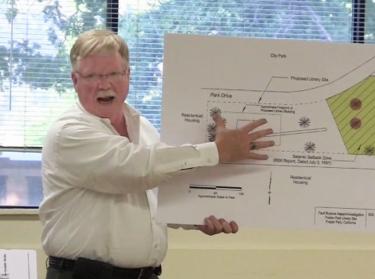
Image 5 of 5
Construction Services Manager Mark Russell, AIA came equipped with charts of the construction site and the fault line over which the trees have grown for hundreds of years. Liability was the main reason the trees had to come down, he said. He did not say who was liable for damaging the trees.
Trees Misidentified by County Arborist After Contractors Maul 300-400 Year-Old Heritage Oak Treasures
By Patric Hedlund
To even amateur eyes, the deep-lobed leaves of the Valley oak (Quercus lobata) are distinctive. This is the species of majestic heritage oaks that have towered above the Frazier Mountain Communities for 400 years.
The trees around which Chumash families gathered to tell whimsical coyote tales are today the trees that motorists must respectfully circumnavigate on their way to visit the Ridge Route Communities Museum, Frazier Mountain Park or the Frazier Park Public Utilities District office— because the road has been humbly built around these giant oaks. They stand smack in the middle of the street and in the middle of local parking lots.
We like it that way. This little bit of inconvenience, the decision to bend toward honoring heritage rather than maximum motorist efficiency, is a reminder, many here say, of why people came to these mountains to live close to nature in the first place: It wakes people up; It shakes off hubris; It is a reminder of what really matters.
Trees that are older than the United States of America deserve to be noticed, people here say. They keep us humble. That is why, when Saturday morning, June 12 dawned with the sound of chainsaws at the new library building site, people of the mountain were shocked.
They didn’t know that months earlier, in April, county bureaucrats in Bakersfield had decided to break a promise made to the Mountain Communities. County workers had decided to cut down trees that Frazier Mountain had been repeatedly promised would be preserved. According to interviews conducted by The Mountain Enterprise this week, it is confirmed that no local arborist was consulted, no local eyes were asked to look over the arborist’s report, no explanation was given to the community in advance.
Yet the arborist’s report used by Kern County Construction Services Division Manager Mark Russell, AIA, to justify the 7 a.m. chainsaw operation on the 90’ centenarians, called these trees Quercus douglasii, or Blue oak—and recommended replacing each of these towering 200-400 year-old trees with single 4-5 foot Blue oak sapling, a species that is not growing in Frazier Park.
The Bakersfield arborist, Conway Lopez of General Tree Service, said in a gracious and candid interview June 21, after viewing photos provided by The Mountain Enterprise, that he made a mistake.
He came up to the mountain in April when there were few leaves showing and he misidentified the trees. He said his main thought was shock at what he saw at the building site.
“I was deeply concerned,” he said. The contractor, Tilton Pacific Construction, and Kern County had failed to take basic industry-standard precautions to preserve the safety of the community’s heritage oaks, as they had promised they would. Ground Breakers of Lebec was a subcontractor for grading.
In his report, dated May 19, 2010 Lopez writes: “The purpose and use of this report is to assess the current condition and damage of Blue oak trees located at the Frazier Park Branch Library where construction is occurring.
“Observations from walking inspection: grade around tree trunk areas has been changed substantially. Other areas the grade has been raised. Major anchor roots have been severed. Many roots are now exposed and causing desiccation.”
Lopez said in the interview that “I’ve traveled in 46 states and I’ve never seen trees butchered like they are in Kern County.”
He said the smaller tree that was removed could have been 200 years old and the larger one may have been alive for 400 years.
If the local community had been consulted, and a second opinion sought from a qualified local arborist, this mistaken identity would have been avoided, but what about avoiding the damage to the trees in the first place?
All involved county personnel were asked to come meet the community Tuesday, June 15 to explain what had happened on the morning of Saturday, June 12. The meeting was chaired by Steve Newman and hosted by Supervisor Ray Watson’s appointed Mountain Communities Municipal Advisory Council (MCMAC), which had a preset meeting to consider lingering community concerns about Watson’s leadership in certifying the large version of the controversial Frazier Park Estates.
In addition to Mark Russell, Matthew Pontes, a Kern County general services division director who said he previously worked with the parks department and once worked with the U.S. Forest Service (as a student) spoke. Watson did not attend. His aide Christy Fitzgerald took notes.
When asked by members of the community if the county had a permit to cut the trees down, county personnel replied, “We don’t need one.”
It was stated that “Kern County is the only county in the state of California without an oak tree ordinance.”
Director of Planning and Community Development Lorelei Oviatt said that her department had taken an oak tree ordinance to the board of supervisors in 2004, but they refused to adopt it. MCMAC member Linda MacKay returned to the question: “Why was there no hearing or a permit from Fish and Game, especially since the director of libraries specifically asked you to put out a press release and to consult a local arborist?”
Pontes replied: “I don’t have a good answer for you on that. It is my position, that we dropped the ball on notification of the public and that the architect had a design that protected the oaks…..”
Frazier Park Architect Max Williams, who tried to protect the trees by placing his body in front of them on June 12, said, “I think that legal action should be taken if they can’t do the basic minimum requirement to protect the oak trees.” He said that “every single oak tree had building supplies stacked under it all the way up to the trunk.”
Throughout California, it is customary on construction sites to erect orange plastic net fencing around heritage oak trees’ drip line, to prevent compacting the earth or cutting the roots that extend out as wide as the spreading branches, or “drip line.”
In most counties, a hearing process is needed in order to remove old growth heritage oaks. It appears that issues that would have been raised in advance by those who wanted to take down the Frazier Park library trees were being raised after the fact by an elaborate county exhibit of the fault line over which these trees had been growing for hundreds of years.
“Any time we have a tree with high probability of failure, you have to mitigate that hazard. In larger areas you can keep people from going underneath it, but this is a parking lot,” Russell and Pontes repeated. The arborist’s report makes it clear that the need to remove the trees was less likely because a fault line exists than because of damage caused by careless construction.
Detail from Arborists Report: [Read full report here]
Tree 1—Blue Oak—60 inch caliper; The health condition of this tree is poor. Lower trunk has 34 inch cavity and substantial root loss from construction activity. The tree is leaning with very little anchorage to support it. Grade has been reduced 42 inches from construction activity. Recommendation—Removal, unsafe situation of no support system to anchor tree.
Tree 2—Blue Oak—31 inch caliper; Health condition is fair. Grade has been reduced 42 inches from construction activity. The tree has a slight lean. Also, the Oak has substantial root loss due to construction. Recommendation—Removal, unsafe situation of no support system to anchor tree
Tree 3—Blue Oak—59 inch caliper; Health condition is good .Some roots have been removed to install a V-gutter. Recommendation—Leave Oak as is.
Tree 4—Blue Oak—Caliper 67 inches; Health condition is fair.
The soil has been compacted around trunk area. Lower trunk area has been damaged by construction. Recommendation— Aerate soil and remove soil from trunk area to heal wound. Oak tree can fail due to soil compaction and lower trunk injury.
Summary Conclusion: In viewing all Oaks, there has been substantial damage to these trees during construction. Trees #1 and #2 should be removed due to potential liability. Tree #3 is healthy and stable. Very little damage has been done to this Oak tree. Tree #4 has surrounding soil that has been compacted and lower trunk area has been damaged due to construction. This can cause die-back in future years to come. Soil should be aerated to allow air and water access to root system.
Anytime construction is to be done near or around trees, a tree fence should be installed around the drip line to protect root systems. Also, apply mulch around drip line during construction to stop desiccation.
Next Week: Can Any Good Come of This?
Read related: Atrocity Community Input, OpEd by Howard Galloway
This is part of the June 25, 2010 online edition of The Mountain Enterprise.
Have an opinion on this matter? We'd like to hear from you.

